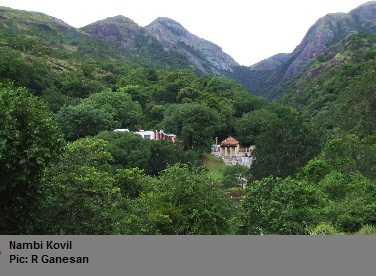Any and all opinions expressed in this newsletter are solely those of the author(s) and do not reflect the opinion of ATREE.
Centre for Excellence in Conservation Science
Royal Enclave,Srirampura,Jakkur Post
Bangalore-560064
Telephone: 080-23635555 (EPABX)
Fax : 080- 23530070
While traveling from Kalakad towards
Thirukurungudi on the bank of Periyakulam
one could see a signage directing you to look
towards the hills westwards for Malaimel
Nambi Kovil. It is a common sight to see
travelers join their palms to worship the Lord
Vishnu, locally called as Nambi. From this
marked vantage point all one can see is a
small white speckle nestled in the laps of lush
green forest clad mountainous landscape. The perennial river, Nambiar descending
from the mountain skirts the temple and flows
down further to irrigate the rice and banana
fields. Near the Malaimel Nambi, a statue of a
deity called Sangili Boothathar is worshipped
by the community from the nearby villages.
Two contrasting cultures seem to conduct
their religious customs to their hill top deities
in an amicable fashion. Nambi Kovil is located in the middle of dry
evergreen forest. Among the many rare
plants found here are medicinal plants such
as Decalepis arayalpathra and Begonia
floccifera. 'Siddhars', who were well versed
about the herbs of health and medicinal
significance, are believed to have flocked to
these hills.
Nambiar river, on both the banks, is lined with mango, naval, pungam, illupai whose
magnificent canopy is interlocked by the
branches and woody climbers such as
'Aanaipuli'. The boulders found in the fast
flowing Nambiar is perhaps the only habitat
for Indotristichia tirunelveliana, a small
aquatic plant anchored firmly. The forest
around the temple supports arboreal
animals such as Thevangu (slender loris) and
the Hanuman manthi (common langur) apart
from birds, amphibians and insects.
Serenity provides the ideal ambience to
those who seek to experience unison with the
mountains. Agasthyamalai encompassing
the Thirukurungudi forests is known as abode
for the great souls like Agasthya, Gorakkar
and several other siddhars. Hence it is hardly
surprising that the dense forests and peaks of
Thirukurungudi far away from hustle bustle of
the human dominated landscape attracted
Nambi, whose main abode is in
Thirukurungudi, eight km at the foothills of
these forests. The Thirumalai Nambi presides in the forests and devotees either
walk or use vehicles to reach this temple.
The other four Nambi's incarnations are
located around Thirukurungudi village at
foothills . Each of these are unique postures
of Nambi – the Ninra Nambi (Standing
posture), the Irundha Nambi (Sitting posture),
the Kidandha Nambi (Sleeping posture), and
the Thiruparkadal Nambi (on the banks of
Nambiar within the village). Thiru Ramanuja
Acharya, a well known Vaishnavite saint is
known to have visited these temples.
As with any Vaishnavaite temple, last
Saturdays of all the Tamil months are
considered sacred and thousands of
devotees throng the temple. The entire
Puratassi month and Pournami day of
Chitthirai month are of special significance.
Nambi Kovil is an important stopover for
thousands of pilgrims and tourists , who visit
the landscape. In the past, with a smaller
population and limited commutation facilities
there was little damage to the surrounding forests. Now, drastic change in the lifestyle
has started to take toll on the forest. Today
polythene, liquor bottles, and leftover of
sacrificial fowls, goats and food items are
common sight than leaf-litter in the forests
and the river near the temple. The forest
around Thirumalai Nambi temple is not only
known as the abode for numerous gods and
holy souls but also is home for several rare
plants and animals and the river Nambiar,
instrumental to bring wealth and prosperity in
the downstream villages. Hence, it will be a
divine injustice if pilgrims continue to pollute
and destroy the inseparably interlinked
Malaimel Nambi Kovil Thirukurungudi forest -
the insignia of culture and biodiversity.
Pilgrims should co-operate with the Forest
Department in maintaining cleanliness and
tranquillity of the habitat that supports divinity
and biodiversity.
Editorial Team
Editor: Allwin Jesudasan
Associate editor: Rajkamal Goswami
Editorial Review: R. Ganesan, M. Soubadra Devy, T. Ganesh
Design and presentation: Kiran Salegame
A S H O K A T R U S T F O R R E S E A R C H I N E C O L O G Y A N D T H E E
N V I R O N M E N T
Malaimel Nambi Kovil – an insignia of culture and biodiversity
- R Ganesan
If you have any suggestions or comments please let us know through the boxes below






